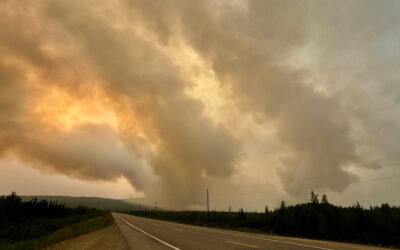
Jessica Bell takes a video as the Dixie Fire burns along Highway 70 in Plumas National Forest, Calif., on Friday, July 16, 2021. (AP Photo/Noah Berger)
SAN FRANCISCO (AP) — Pacific Gas & Electric reported to California utility regulators that its equipment may have been involved in the start of a fire burning in the Sierra Nevada that is threatening hundreds of homes.
PG&E said in a report Sunday to the California Public Utilities Commission that a repairman responding to a circuit outage on July 13 spotted blown fuses in a conductor atop a pole, a tree leaning into the conductor and fire at the base of the tree.
The utility said its system showed around 7 a.m. that the Cresta Dam off Highway 70 had lost power but because of the steep, rough terrain, the worker sent to check it couldn’t reach the area until nearly 5 p.m.
The employee reported the fire to his supervisor who called 911 and the dispatcher said they were aware of the fire and responding. Firefighters with the California Department of Forestry and Fire Prevention began dropping water and fire retardant about 5:30 p.m., the utility said.
By that night, the blaze had grown to 10 to 15 acres (4 to 6 hectares) and firefighting crews on the ground had problems accessing the area, it said.
Cal Fire investigators collected portions of a power line, including the conductor, jumpers, insulators, and fuse cutouts, and parts of the tree.
The Dixie Fire roared to new life Sunday, prompting evacuation orders in rural communities near the Feather River Canyon and had grown to nearly 63 square miles (163 square kilometers) Monday, largely in remote wilderness. It was reported to be 15% contained.
The fire is burning northeast of the town of Paradise, where survivors of a 2018 fire that was started by PG&E equipment killed 85 watched warily.
PG&E equipment has been blamed for sparking some of the state’s deadliest wildfires in recent years, most notably in 2017 and 2018 when a series of wildfires burned down more than 28,000 buildings and killed more than 100 people. It emerged from bankruptcy last year after a series of deadly wildfires ignited by its long-neglected electrical grid prompted it to declare financial insolvency.
Gov. Gavin Newsom said he would wait to comment on the utility’s possible involvement until the investigation is completed.
“These things all deserve an investigation and I’m not going to jump to any conclusions,” Newsom said Monday. He said his administration continues “to do more to demand from PG&E and other investor-owned utilities real accountability” for investing in wildfire suppression, camera detection technology and making sure they are “doing the forest management and vegetation management which are foundational to wildfire prevention.”
Meteorologists predicted critically dangerous fire weather with lightning possible through at least Monday in both California and southern Oregon. Noting the dry conditions, the National Weather Service in Sacramento said “any thunderstorm has the potential to ignite new fire starts.”
Extremely dry conditions and heat waves tied to climate change have swept the region, making wildfires harder to fight. Climate change has made the West much warmer and drier in the past 30 years and will continue to make weather more extreme and wildfires more frequent and destructive.
Firefighters said in July they were facing conditions more typical of late summer or fall.




